No more bulky boilers and stoves! They will be replaced by wall-mounted electric heating convectors with a thermostat
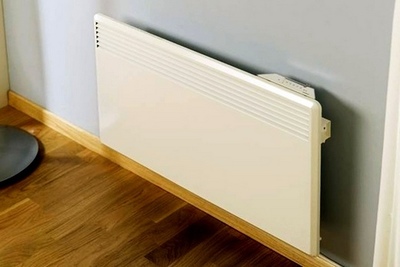
Electric convector – popular type of autonomous heaters for domestic, industrial and office premises.
The device helps to create a comfortable atmosphere, is installed when the central heating is not working properly or is the main source of heat.
One of the advantages of an electric convector is the presence of a thermostat, automatically controlling the degree of heating of the roomThis feature of the device allows for rational use of electricity and ensures its safe operation.
Content
Wall mounted electric convector heating
Among the variety of modern heating devices, an electric wall convector is the best option. It takes up minimal space and saves space indoors.
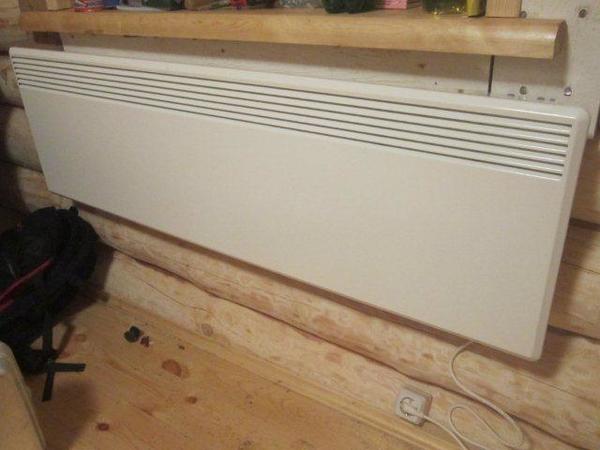
Photo 1. Wall-mounted electric convector for heating the room. Next to the device there is a socket for connecting it to the network.
Design and operating principle
The design of the device is simple. It consists of the following parts:
- metal body with a grille at the bottom and exhaust curtains at the top;
- closed heating element (TEN);
- air temperature sensor;
- thermostat;
- power button.
Important! Modern models additionally equipped with overheating protection in the form of a special sensor that switches off the device.
Externally, the wall-mounted electric convector resembles a conventional heating radiator. Convector operation based on the natural circulation of air flows. Cold air enters the device body through the lower grille, warms up, becomes lighter, then, under the influence of gravity, is displaced by a new portion of cold air and goes out through the upper guide curtains. Mixing with air masses, it cools down and again enters the converter body.
The process occurs continuously, as a result the room is heated evenly. The thermostat built into the convector is responsible for regulating the temperature level in the room. Its function is to turn off the device when the set temperature is reached and turn it on when it drops.
Advantages and disadvantages
Electric convector provides primary and additional heating of air. Compared to traditional methods of heating It has a number of advantages:
- Efficiency combined with silence. In terms of heating speed, the convector is inferior to fan heaters. However, it uses less energy and works quietly, with barely audible clicks.
- Soft warm-up air without drying it out.
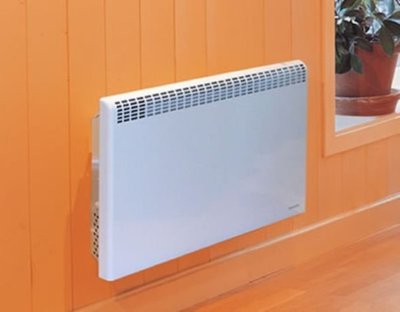
- Compactness.
- Easy, do-it-yourself installation And convenient operation.
- No need for special maintenance and installation approval.
- Ergonomic design. Convectors fit well into the interior of any room.
- Affordable price.
Flaws:
- Decrease in efficiency as used.
- The need for frequent wet cleaning premises to eliminate dust circulating in the air. This circumstance should be taken into account by people prone to allergies and suffering from respiratory diseases.
- Low efficiency over large areas.
Installation rules
The installation of a convector requires a minimum of space, so it can be placed in any part of the room. But the main thing during installation is compliance with recommendations for ensuring efficient operation and normal air circulation:
- height from floor — 20 cm;
- gap from the wall — 20-25 mm.;
- distance from side objects - not less than 50 cm;
- gap at the top and front - not less than 50 cm.;
- distance to socket - not less than 30 cm.;
- voltage-resistant electrical wiring minimum 3.5 kVT.
Types of thermostats
Electric convectors are divided into two groups, depending on the type of thermostats installed in them. Each of them has its own technical characteristics.
Mechanical
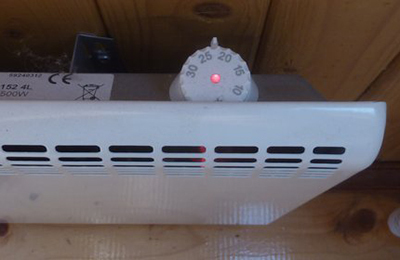
Convectors with mechanical thermostat have a simple design and are therefore more reliable.
This is a regular heating device that works with an electric heating element. The convector heats up until the room temperature reaches the set level.
Then the heating element contacts open. A new connection occurs automatically after the air cools down.
Pros and cons
Electric convectors with mechanical thermostats have a number of advantages:
- low cost;
- safety and independence from voltage fluctuations in the network;
- environmentally friendly, due to the low temperature of the heating element.
The disadvantage of such models is It is considered impossible to achieve high-precision temperature control.
How to regulate
Convectors with mechanical thermostatm have a step-by-step adjustment systemand temperature, operating in three modes:
- Economical — operation in the minimum range. Insignificant heating of air is produced.
- Comfortable — optimal air heating.
- Maximum - powerful heating in a short period.
In expensive models the range of modes is wider. The operation of the thermostat is checked experimentally. The user selects one of the modes and controls the air temperature in the room with a regular thermometer.
Electronic
Electric convector with electronic thermostat — a high-precision device that operates in automatic mode.
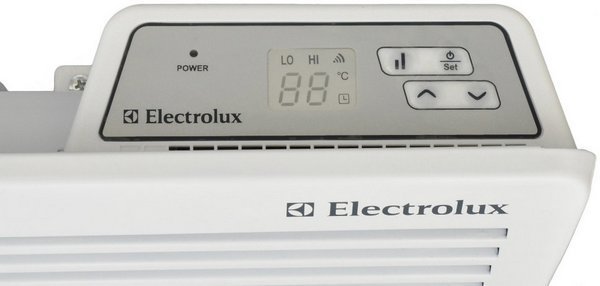
Photo 2. Electronic thermostat from an electric convector. The heating temperature of the device is indicated on the monitor.
Operating principle
The convector with an electronic thermostat operates in automatic mode and does not require human control. The operation of the device is regulated by a high-precision sensor, which sends a signal to the controller, which turns the convector on and off as needed.
Control of models with electronic thermostat is a complex computer system, programmable automatically. The user only needs to set the required temperature, and the device will provide heating on its own.
Technical specifications
Convectors with electronic thermostat are equipped with the following functions:
- antifreeze - maintaining the temperature at a level plus 5 °C in the absence of residents;
- high-precision temperature sensor;
- control by remote control.
Advantages and disadvantages
Compared to mechanical models, electronic ones have the following advantages:
- precise temperature control;
- convenient control;
- energy saving up to 10%;
- Possibility of setting day and night temperature modes.
The only drawback of models with electronic thermostats is high cost. Although energy savings compensate for this disadvantage.
How to regulate
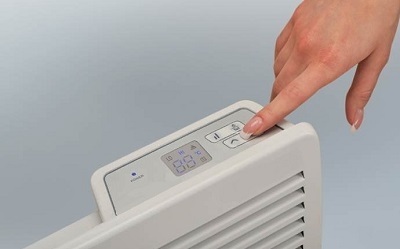
Setting range for convector with electronic thermostat from 0 to 35 °C. If you need to quickly warm up the room, set the maximum mode. In this case, the device works continuously.
With 24-hour operation set a temperature that is comfortable for residents. The convector regulates it independently, periodically turning on and off.
Manufacturers overview
The modern market offers consumers a wide selection of wall-mounted convectors with mechanical and electronic thermostats. The most popular manufacturers are:
- Timberk (Sweden).
- Noirot (France).
- Nobo (Norway).
The companies produce convectors of two modifications:
- TEC.E2 — with mechanical thermostats, power 1500 W. Price from 1900 to 3500 RUR
- TEC.E1 — with electronic ones. Cost from 4500 to 6500 RUR.
The most expensive models with electronic thermostat and power up to 2 thousand W offers a Norwegian company Nobo. Prices from 8100 to 15 thousand rubles.
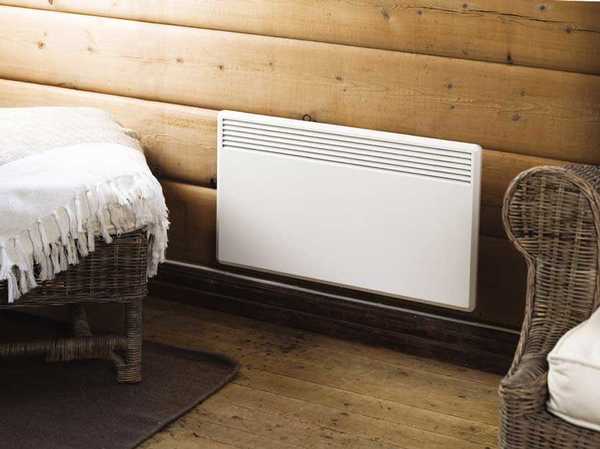
Photo 3. Electric convector from the manufacturer Nobo. The model has a stylish design and fairly compact dimensions.
The company deserves special mention Arbonia, which produces tubular convectors. The cost of the devices depends on the design and size.
Reference. The best budget convectors from companies Ballu and Resanta are produced in Russia, so their cost is lower than foreign models. However, domestic devices are not inferior to imported ones in terms of reliability and efficiency.
How to choose an electric convector
The successful operation of an electric convector depends on the correct choice, which The following parameters influence:
- Purpose. If you intend to use the device as an additional element when the main heating is not working properly, you can limit yourself to a low-power model with a mechanical thermostat. As the main heat source, it is preferable to choose a convector with electronic control and additional functions.
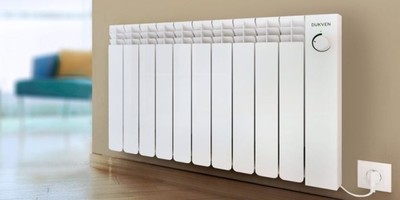
- To create a comfortable temperature, a device is used, the power of which will be sufficient to heat a specific roomWhen choosing, take into account the area, height of the ceilings, and the presence of heat loss.
- An important condition for the safety of a convector is reliable body. Its height directly affects the power of the device and its convection capacity. For a small area, a device measuring 50-60 cmThe thickness of the case is no less important.
- When choosing a model, take into account the type of thermostat. Mechanical ones require human control and do not withstand constant loads well. Electronic ones are highly reliable and energy efficient, which justifies the higher price. Programmable ones are equipped with remote control. They can be switched on via GSM notification from a great distance.
Useful video
Watch a video that explains how convectors heat a house and how much such heating costs.
Wall-mounted electric convectors – fast heat in a reliable casing
A wall-mounted electric convector is an effective device for organizing both additional and autonomous heating of any room. Its main advantage is the presence of an overheating protection function And ensuring uninterrupted operation without user control. A wide range of models allows each consumer to choose the appropriate option based on the price and required power of the heating device.









Comments